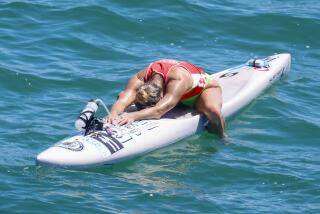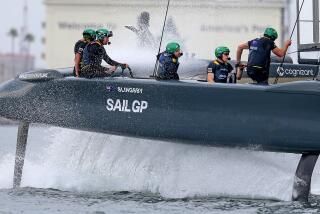Ships of the Desert : Land Sailors Achieve Speeds of 90 M.P.H. by Using the Wind That Really Isnât There
Nord Embroden invites someone to go sailing, and then asks: âWhat size helmet do you wear?â
If that is surprising, wait until Embroden arrives at the site and sees that the course is too wet to sail.
The sport is land sailing, and several dozen devotees compete in the desert on what they call land yachts. They hope their venue will be dry enough for that part of the 63rd Midwinter Regatta to be contested on a lake near Barstow this weekend--a dry lake, Superior No. 3.
The world speed record for a sailboat on water is 38.13 knots (43.9 m.p.h.), set by Russell Long of the United States on Bodega Bay, north of San Francisco last year. Land sailors routinely achieve speeds that high. Thatâs why they wear helmets.
Embroden once held the world record at 88.4 m.p.h.
âYeah, (the wind) was blowing about 40 (knots) that day,â he says.
Bertrand Lambert of France holds the record at 94.0 m.p.h., but Embroden says the wind wasnât blowing half that hard on that day.
How is that possible?
It has to do with apparent wind, as opposed to true wind.
Toss some grass into the air, and you can deduce the direction of the true wind. The wind felt when you stick a hand out of the window of a moving vehicle is an example of apparent wind. When the vehicle stops, the wind stops. Now imagine that vehicle is a sailboat, with all that apparent wind powering your sails. In a land yacht, the trick is getting up to that speed.
No sail boats can sail directly into the wind, but with sails shaped like air foils, they are able to sail at 45-degree angles into the wind, gathering wind--and speed--as they move along.
Land yachts, like ice boats, have a major advantage over conventional sailboats in that they have much friction to hold them back.
Skilled sailors understand apparent wind but, with heavy keels underneath their boats for ballast, are limited in exploiting it because of friction created by the water.
Even the modern Americaâs Cup boats can sail only at about the approximate speed of the true wind. If it is blowing six or seven knots off San Diego, they will average six or seven knots for a race.
Catamaran sailors, handicapped by less friction, do a little better.
But if you have enough wind--say, five to 10 knots--to get a land yacht moving and the skill to trim the sail properly, the craft will steadily generate and continue to increase its own apparent wind until it is traveling at four or five times the velocity of the true wind.
Embroden said: âWe had a water sailor who came out here with what he thought was the hot ticket: a spinnaker.â
The sailor raised the large, billowing sail in front of his land yacht, headed downwind on the true wind--and couldnât understand why all the other land yachts were flying past him. Apparent wind.
In fact, there often is a phenomenon during the land sailorsâ races when a competitor will lose his delicate sail trim, spill the apparent wind and roll to a stop as rivals sweep past.
With all of this explained, Embroden ventures out for a day of sailing on El Mirage Dry Lake west of Victorville, towing a couple of disassembled land yachts on a trailer.
First they drive to the west end of El Mirage, where they wonât have to compete for space with motorcycles and off-road vehicles. But a recent storm has left standing water on the lake bed, so they turn around and go to the east end, where the wind and bikers are stirring up dust.
Embroden first sailed a land yacht on the beach at Long Beach in the late â50s when he was 8. He has won two world championships, including last year on the beach at Lytham on Englandâs northeast coast.
For 10 years he worked full time building land yachts, which sell for up to $18,000 for a high-performance model. Embroden also teaches drafting and design at Victor Valley College.
Embroden says land sailing was more popular in the United States in past years.
âI first came out here in â68,â Embroden said. âWe used to race in (the early â70s). Every other weekend, weâd have a hundred yachts.
âThen that club kind of folded. Part of it was the development of new yachts. When I first started, guys were just building things out of pipes and wheelbarrow wheels. Then, as more sophisticated yachts came along, we didnât develop classes so people could still run in their (older) classes, so we lost some people from the early days.â
These days, competition in the United States is governed by the American Land Sailing Federation and the North American Land Sailing Federation. Organizations include the Pacific Land Yacht Club, the U.S. Manta Organization and the Wind Wizards.
At some dry lakes, the land yachts compete for space with motorcycles, ultralight aircraft and off-road vehicles.
âThe bikers like to come alongside to see how fast weâre going,â Embroden said. âThey donât realize that, with the wind noise and the way weâre scrunched down, we canât always see them or hear them and that we sometimes turn suddenly.â
Land sailors tell the story of a biker who flew right through the sail of a land yacht.
Otherwise, Embroden says, the sport is relatively safe, once a person gets the hang of it.
âBeginners get out there and flip over within the first 10 feet,â he said. âThey sheet the sail in flat, the wind hits the sail and it flips over.
âBut the faster a yacht goes, the more stable it becomes. If you turn real sharp at high speeds, of course, you can roll it, but the yacht is more stable under load because of the down forces of the rig.
âWhen a sailboat heels, it releases some pressure. We donât heel until our side forces equal our stability, and we can adjust that by letting our shrouds out to put more down force on the (wheels).â
The land sailors donât bother with the complex yacht racing rules.
âIf you get two yachts closing at (a combined) 120 m.p.h., you donât have time to think about what tack youâre on,â Embroden said. âSo weâve come up with a rule that a yacht on your right has the right of way. There arenât many protests.â
Sitting low to the ground, a sailor steers by turning the front wheel with foot pedals and holds the mainsheet, the line controlling sail trim, in his hands. He feels a gentle rumble and the wind. As he accelerates, he trims in the sail . . . 20, 25, 30, 35 . . . 40 m.p.h.!
âThis is my ocean out here,â Embroden says. âIt has the same freedom and openness. You look out over the vast expanse of area and it has that same sort of feeling.â
More to Read
Sign up for The Wild
Weâll help you find the best places to hike, bike and run, as well as the perfect silent spots for meditation and yoga.
You may occasionally receive promotional content from the Los Angeles Times.






